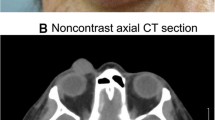Abstract
KR is a 28-year-old man who noted some fullness in the outer part of his left upper lid. He thought he could feel some firmness and mild tenderness just below the upper outer rim of the orbital bone. Examination by his ophthalmologist confirmed these findings with inferior displacement of the globe by 2 mm. Echography was performed in the office and showed enlargement of the left lacrimal gland to 18.5 mm and high internal reflectivity, which became lower as the spikes traveled across the gland (Fig. 1). This was suspicious for a benign mixed cell tumor, and he was referred for CT scanning and then to an orbit surgeon for an en bloc excision of the lacrimal gland.
You have full access to this open access chapter, Download chapter PDF
Similar content being viewed by others
Keywords
These keywords were added by machine and not by the authors. This process is experimental and the keywords may be updated as the learning algorithm improves.
KR is a 28-year-old man who noted some fullness in the outer part of his left upper lid. He thought he could feel some firmness and mild tenderness just below the upper outer rim of the orbital bone. Examination by his ophthalmologist confirmed these findings with inferior displacement of the globe by 2 mm. Echography was performed in the office and showed enlargement of the left lacrimal gland to 18.5 mm and high internal reflectivity, which became lower as the spikes traveled across the gland (Fig. 1). This was suspicious for a benign mixed cell tumor, and he was referred for CT scanning and then to an orbit surgeon for an en bloc excision of the lacrimal gland.
Anterior orbital lesions can involve the eyelids with resultant swelling. Echography is a very useful office test to quickly screen for such lesions with some posterior extension back into the orbit. A relatively common tumor in children with such presentation is the infantile or capillary hemangioma.
This can grow rapidly with a doubling time of weeks and must be differentiated from more serious tumors such as rhabdomyosarcoma.
Author information
Authors and Affiliations
Rights and permissions
Copyright information
© 2014 Springer Science+Business Media New York
About this chapter
Cite this chapter
Harrie, R.P., Kendall, C.J. (2014). Case Study 20 Pleomorphic Adenoma of Lacrimal Gland. In: Clinical Ophthalmic Echography. Springer, New York, NY. https://doi.org/10.1007/978-1-4614-7082-3_20
Download citation
DOI: https://doi.org/10.1007/978-1-4614-7082-3_20
Published:
Publisher Name: Springer, New York, NY
Print ISBN: 978-1-4614-7081-6
Online ISBN: 978-1-4614-7082-3
eBook Packages: MedicineMedicine (R0)





